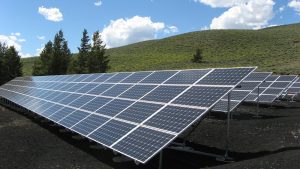“If you were to go out to FedEx Field to see the Washington Football Team, nearby is billions of dollars worth of art—and you would never know it,” Prof. Lisa Strong, director of Georgetown’s Art and Museum Studies Program, says.
A small plaque is the only signifier of the prized artifacts behind the doors of the nondescript building that houses a large part of the Smithsonian Institution’s collection, as well as the collections of private owners. The Maryland storage facility safeguards the collections against decay and weather, but the objects housed in the museums on the National Mall are at much greater risk.
Many of the museums built on the Mall have experienced major flooding events, threatening collections stored onsite below ground level and even galleries. As a warming climate is projected to cause further sea level rise and increase the incidence of extreme weather events—major floods have doubled in the past few decades—these institutions face new collection conservation and museum sustainability challenges.
The scale of the threat becomes apparent when considering the size of the 19 Smithsonian institutions and their combined collections of 155 million objects. The objects these museums collect and display attempt to tell the story of the United States, be it through the lens of art, historical documents, or cultural touchstones. Even if those efforts fall short, as climate change shapes the nation’s present and future, its effects are also taking a toll on the nation’s past.
Storms in the last two decades have piled up to three feet of water onto Constitution Ave, resulting in floods that swept into museum galleries and storage levels. The National Museum of American History and the National Museum of Natural History, built in 1964 and 1911 respectively, are the two most at-risk institutions on the Mall. A lack of funding for major infrastructure projects has led to ad hoc measures aimed at short-term protection of their onsite collections.
Climate projections predict extensive flooding along the Mall with a global temperature increase of 1.4 degrees Celsius; the same projections are even more catastrophic at two degrees.
“The Mall’s a tricky place to build because it’s reclaimed swamp,” Carlos Bustamante, associate director of project management and planning at the National Museum of African American History and Culture (NMAAHC), said. As the most recent addition to the Smithsonian, NMAAHC has taken measures to control its exposure to extreme weather events, including flooding.
With the benefit of hindsight to aid its construction in 2016, NMAAHC is better protected than most other buildings on the Mall. Bustamante described three cisterns built 60 feet below grade that collect incoming water and guide it away from the facility, as well as a pump system that handles thousands of gallons of water each day, protecting the building against ruinous flooding.
“These systems are designed to be hundred-year systems, to look at what’s happening and project forward and be robust enough to handle the cataclysmic extreme weather events,” he said.
Some of the older buildings have already shown signs of wear and tear due to rising sea levels and the high Potomac water table. “Many of these museums, especially in D.C., were built before we saw the extreme weather events and temperature increases, and they’re not really meant to handle this type of extreme weather,” according to Rebecca Kennedy, who managed collections for the Smithsonian for more than a decade.
The severity of the issue is no secret. Even a 2021 Smithsonian climate vulnerability assessment reads, “Severe storm events causing flooding could outpace the Smithsonian’s current capacity to fund and execute projects to provide increased individual site and building resilience at its most vulnerable National Mall facilities.”
The report describes potential resiliency projects, such as flood walls at the National Museum of American History—which would cost $38.9 million—and a National Mall water pumping station shared among all the buildings in the space—with a price tag of $400 million. The National Air & Space Museum installed flood walls during its recent renovation, but other projects have not come to fruition, both due to their prohibitive cost and the division of responsibility for climate response among numerous government agencies.
Although the problems they face are mounting, museums have always made climate integral to their operation. The standards for climate control in museum galleries are strict to ensure objects are not damaged, and HVAC systems carefully monitor temperature and humidity fluctuations. “You never think of museums as being on the cutting edge of anything, but in many ways, they were uniquely prepared for these challenges,” Strong said, adding that the advanced filtration systems in museums have also protected visitors during the COVID-19 pandemic.
Paradoxically, some museum practices contribute to the climate problems they face; Strong said discussions have increased in recent years around improving the sustainability of these institutions. “You do want to control it, but the environmental recommendations are so specific that museums have to use a lot of energy to meet them,” Strong said. As fluctuations in temperature and humidity increase, museum climate control systems will be working harder to maintain an environment that looks less and less like the one outside their walls.
Despite the prevailing adherence to strict guidelines, some museums and researchers are challenging those recommendations, according to Anne Kingery-Schwartz, who specializes in object conservation for museums and teaches in the art and museum studies program at Georgetown. “There’s been a lot of discussion recently about relaxing those standards and if those standards are really the right ones because they’re a little bit based on human comfort and then preventing fluctuations from there,” she said. The standards for gallery temperature and humidity also date back to the 1970s, before advancements in conservation science.
One way to use less energy in the process is allowing for greater variation in the humidity of museum climates. “There’s some research that the seasonal fluctuations from a humid summer to a dry winter are not so bad because they’re gradual, so the objects can acclimatize,” Kingery-Schwartz said.
Short-term fluctuations are dangerous for objects like oil paintings, which are often done on canvases stretched over wooden frames. If the wood expands or contracts too quickly, the paint cracks and flakes. But the dangers may be significantly reduced to objects if the fluctuations are more gradual, allowing museums to mirror the outside temperature and humidity more closely throughout the year and save energy.
Museum conservators are paying increasing attention to the ways their practices contribute to problems they ultimately try to fix. Airborne pollutants, including sulfur and carbon dioxide from industrial processes, can combine with other elements to leave deposits on museum objects. Museum waste, as well, can end up feeding plastic and hazardous pollution into landfills and oceans.
While part of the effort to make collection management more sustainable includes replacing old storage materials, such as wooden cabinets and foam packing, updating also creates new waste problems. “Especially if those cabinets cannot be reused because hazardous collections have been stored in them, then you’re just creating a lot of trash when you replace your old storage cabinets with new,” Kingery-Schwartz said.
Traveling collections and loans to other institutions, which make up a large part of the Smithsonian’s effort to make its collection widely accessible, also face sustainability challenges.
“It’s a very important part of our coordination and helping out other museums, the museums that want to tell the stories but may not have the objects,” Bustamante said. In order to receive loans, partner institutions must legally commit to the same standards of collection care as the Smithsonian. Museums that allow for a broader range of temperature and humidity may not secure loan agreements, hurting their access to collections.
Blockbuster art shows that collect objects from institutions around the world are among the worst energy-abusers, according to Strong. The energy cost of transporting large crates of artwork by plane or ship became especially apparent when shows were canceled during the pandemic. Moving forward, she made a case for such large-scale displays only when there is a clear benefit to collecting an artist’s works in one place and making them available to the public and researchers.
“I would hope there will be less frivolous blockbusters and that we would only expend the energy on a show like a van Eyck or a Vermeer where there’s a real value to seeing all the artworks together and we as art historians would get on a plane to go see that,” Strong said.
During the pandemic in particular, many museums began to expand their collections digitally, pointing to a future of widespread knowledge and culture sharing that doesn’t require the same energy-intensive methods.
NMAAHC took the opportunity to launch its searchable virtual museum collection in 2021. “As horrible as the pandemic has been, it has forced our hand to make sure that we create as robust a digital experience as possible while we were closed,” Bustamante said. “We dug deep into these projects, and the searchable museum is a beautiful example of what can be done in terms of lifting the physical out of the gallery and putting it into the hands of hundreds of thousands, if not millions, of people who would never have seen it.” In its first few weeks public, the project reached audiences in more than a hundred different countries. The new NMAAHC digital collection is indicative of how the Smithsonian hopes to move forward in the pedagogic space.
To this end, the Smithsonian also offers learning labs to help teachers incorporate digital collections into their classrooms, and it is not going unnoticed. “The Smithsonian is doing a lot to try to make their collections accessible and relevant online,” Strong said.
While the importance of online museum integration cannot be understated, digital collections may never be a true substitute for the ability to see priceless artifacts and materials in person. So, the pursuit of collection preservation is continuing in earnest.
“We can’t stay where we are and keep doing what we’re doing as climate change continues to get worse,” Kennedy said. A former Smithsonian employee, Kennedy started her own business in 2018 to offer conservator services and consultation to museums in the U.S. and abroad. “I wanted to get ahead of the metaphorical and literal fires. I started it to take these small contracts around the world to help with collections care at museums,” she said.
Movement on these changes, however, requires a coordinated effort. “All these things are incredibly challenging from a diplomatic standpoint. It’s a big decision to make; you’re writing new policy,” Kingery-Schwartz said.
Kennedy also addressed the inertia of the museum world in making these changes, adding that the most significant resistance comes from securing administrator buy-in. In D.C., the issue is complicated by the Smithsonian’s partial reliance on federal funding, which is tightly earmarked for specific purposes and times, and the political connections of many of the people responsible for decision-making at the highest level.
“We turn to our heritage in times of crisis for comfort and support,” Kennedy said. “So it’s always interesting that we don’t take care of it when considering climate change.”






Yeah, for anyone who has actually been to the Smithsonian, the idea that water level rise in the ocean would flood their basements in WDC, is ridiculous. This is the same intuition that refuses to recognize Clarence Thomas. Just another alarmist article with no basis in fact.